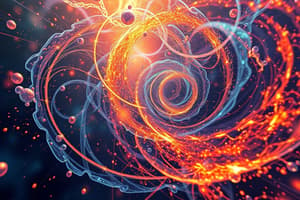Podcast
Questions and Answers
According to the Kinetic Molecular Theory (KMT), which assumption is made about the interactions between gas particles?
According to the Kinetic Molecular Theory (KMT), which assumption is made about the interactions between gas particles?
- Gas particles exert repulsive forces on each other
- Gas particles have no interaction forces acting between them (correct)
- Gas particles experience both attractive and repulsive forces
- Gas particles exert attractive forces on each other
What is the assumption made by the KMT regarding collisions between gas particles and the container walls?
What is the assumption made by the KMT regarding collisions between gas particles and the container walls?
- Collisions involve a transfer of kinetic energy from the particles to the walls
- Collisions are elastic, with no transfer or exchange of kinetic energy (correct)
- Collisions involve a transfer of kinetic energy from the walls to the particles
- Collisions are inelastic, resulting in a loss of kinetic energy
According to the KMT, how is the motion of gas particles described?
According to the KMT, how is the motion of gas particles described?
- Gas particles move in a straight line with varying speeds
- Gas particles move in a coordinated manner with constant speeds
- Gas particles remain stationary, with no motion
- Gas particles move in random directions with varying speeds (correct)
What is the relationship between the average kinetic energy of gas particles and the temperature of the gas, according to the KMT?
What is the relationship between the average kinetic energy of gas particles and the temperature of the gas, according to the KMT?
Which assumption is made by the KMT regarding the volume occupied by gas molecules compared to the total volume of the gas?
Which assumption is made by the KMT regarding the volume occupied by gas molecules compared to the total volume of the gas?
Flashcards are hidden until you start studying
Study Notes
Understanding Kinetic Molecular Theory: Particle Motion, Temperature, Ideal Gas Behavior, and Kinetic Theory Assumptions
Introduction
The Kinetic Molecular Theory (KMT) is a fundamental concept in chemistry used to explain the behavior of gases. It is based on the idea that gases are made up of tiny particles (atoms or molecules) that are in constant motion. These particles are assumed to be spherical and do not attract or repel each other. They collide elastically with each other and the walls of their container, and their average kinetic energy depends on the temperature of the gas. This theory provides a framework to understand various properties and the laws governing gases.
Particle Motion and Temperature
According to KMT, gas particles are always in motion, moving in straight lines until they collide with another particle or the container walls. The temperature of a gas is proportional to its average kinetic energy, which is determined by the average speed of its particles. As the temperature increases, the average speed of the particles increases, resulting in a higher average kinetic energy. Conversely, as the temperature decreases, the average speed decreases, leading to a lower average kinetic energy.
Ideal Gas Behavior
An ideal gas is a hypothetical gas whose behavior perfectly conforms to the assumptions of KMT. Real gases deviate from ideal behavior due to factors like interatomic forces, particle size differences, and non-spherical shapes. However, under specific conditions, real gases closely approximate ideal gas behavior.
Kinetic Theory Assumptions
The KMT relies on several key assumptions:
- No Interaction Forces: Gas particles are assumed to have no attractive or repulsive forces acting between them, similar to the behavior observed in billiards balls.
- Elastic Collisions: All collisions between particles and the container walls are considered elastic, meaning there is no transfer or exchange of kinetic energy. The total kinetic energy before and after the collision remains unchanged.
- Constant Random Motion: Gas particles move in random directions with varying speeds. Their motion is independent of each other, and their interactions result in a redistribution of kinetic energy.
- Temperature Dependence: The average kinetic energy of gas particles is directly proportional to the temperature of the gas. Higher temperatures correspond to higher average kinetic energy, leading to faster particle speeds.
- Volume and Molecules: The total volume occupied by the molecules of a gas is negligible compared to the volume of the gas itself, assuming ideal behavior.
Studying That Suits You
Use AI to generate personalized quizzes and flashcards to suit your learning preferences.




